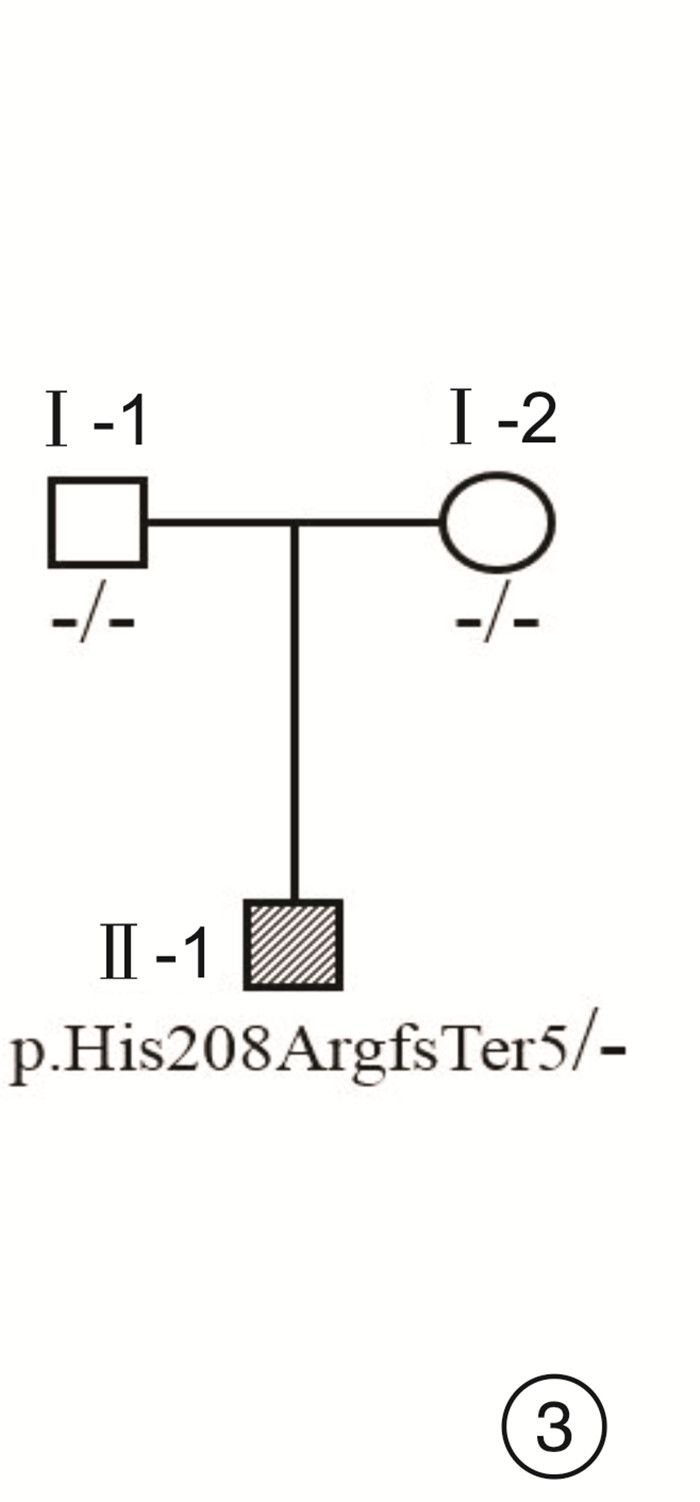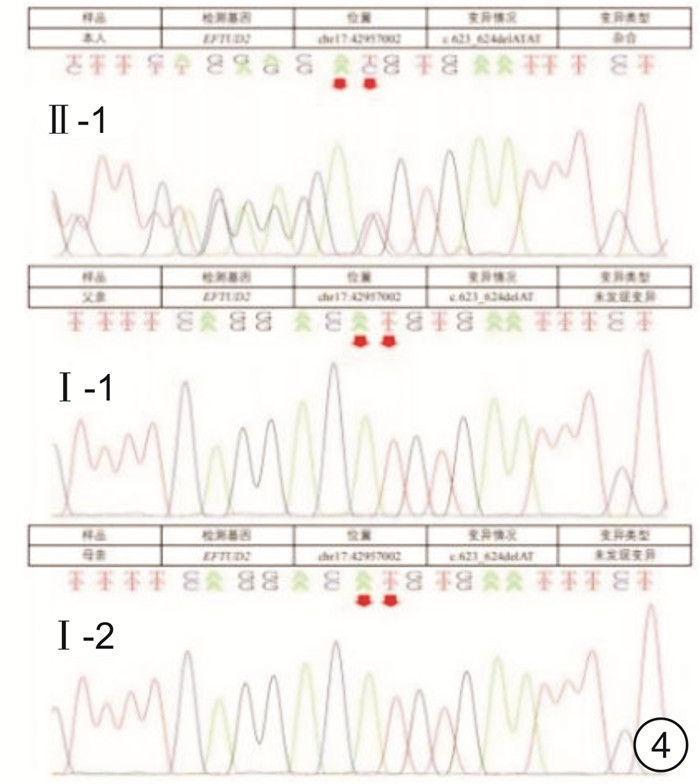Clinical case analysis and literature review of mandibulofacial dysostosis with microcephaly syndrome
-
摘要: 目的 分析探讨罕见的下颌骨颜面发育不全伴小头畸形(MFDM)的临床诊断、耳科学治疗以及分子病因学特征。方法 对先证者进行详细的病史采集,系统查体及表型特征分析,以及听力学检查,胸部X线、颞骨CT和颅脑MRI等影像学检查。同时提取先证者及其父母血液DNA进行全外显子组测序,并检索PubMed、中国知网数据库,对截止2020年底前报道的由EFTUD2基因突变导致的MFDM临床特征进行筛选、归纳和总结。结果 患儿表现为耳廓发育不良、小下颌、小头畸形,同时合并发育迟缓、双耳极重度感音神经性聋,中耳及内耳发育畸形,基因学检测发现EFTUD2基因的新生缺失变异c.623_624delAT。根据临床特征及基因学检测结果诊断为MFDM。行双侧人工耳蜗植入手术,术中及开机后部分电极反应良好。结论 这是国内首次报道的EFTUD2基因突变导致的MFDM,对该患儿进行人工耳蜗植入术的关键在于术中避免损伤畸形的面神经,术后言语康复效果与患儿智力发育等多因素相关。
-
关键词:
- 下颌骨颜面发育不全伴小头畸形 /
- EFTUD2基因 /
- 聋 /
- 耳蜗植入术
Abstract: Objective To explore the clinical diagnosis, otological treatment and molecular etiology in a rare syndromic hearing loss case characterized by mandibulofacial dysostosis with microcephaly(MFDM).Methods The proband underwent detailed history collection, systematic physical examination and phenotypic analysis, as well as audiological examination, chest X-ray, temporal bone CT and brain MRI and other imaging examinations. The blood DNA of the proband and his parents was extracted and tested by the whole exom sequencing. The EFTUD2-related-MFDM literatures published by the end of 2020 were searched and sifted in PubMed and CNKI databases, the clinical characteristics of MFDM were summarized.Results In this study, the patient presented with hypoplasia of auricle, micrognathia, microcephaly, developmental retardation, severe sensorineural hearing loss in both ears, and developmental malformation of middle and inner ear. Genetic analysis revealed a de novo deletion c.623_624delAT in EFTUD2 gene. According to the clinical features and genetic test results, the patient was diagnosed as MFDM. In order to solve the problem of hearing loss, the patient was further performed bilateral cochlear implantation, and part of the electrodes responded well during and after operation.Conclusion This is the first domestic reported case of MFDM caused by EFTUD2 gene mutation. The key problem of cochlear implantation for this kind of patient is to avoid damaging the malformed facial nerve during the operation.The effect of speech rehabilitation after cochlear implant operation is related to many factors such as intelligence development of the patients. -

-
[1] Wu J, Yang Y, He Y, et al. EFTUD2 gene deficiency disrupts osteoblast maturation and inhibits chondrocyte differentiation via activation of the p53 signaling pathway[J]. Hum Genomics, 2019, 13(1): 63. doi: 10.1186/s40246-019-0238-y
[2] Lines MA, Huang L, Schwartzentruber J, et al. Haploinsufficiency of a spliceosomal GTPase encoded by EFTUD2 causes mandibulofacial dysostosis with microcephaly[J]. Am J Hum Genet, 2012, 90(2): 369-377. doi: 10.1016/j.ajhg.2011.12.023
[3] Gordon CT, Petit F, Oufadem M, et al. EFTUD2 haploinsufficiency leads to syndromic oesophageal atresia[J]. J Med Genet, 2012, 49(12): 737-746. doi: 10.1136/jmedgenet-2012-101173
[4] Need AC, Shashi V, Hitomi Y, et al. Clinical application of exome sequencing in undiagnosed genetic conditions[J]. J Med Genet, 2012, 49(6): 353-361. doi: 10.1136/jmedgenet-2012-100819
[5] Bernier FP, Caluseriu O, Ng S, et al. Haploinsufficiency of SF3B4, a component of the pre-mRNA spliceosomal complex, causes Nager syndrome[J]. Am J Hum Genet, 2012, 90(5): 925-933. doi: 10.1016/j.ajhg.2012.04.004
[6] Luquetti DV, Hing AV, Rieder MJ, et al. "Mandibulofacial dysostosis with microcephaly" caused by EFTUD2 mutations: expanding the phenotype[J]. Am J Med Genet A, 2013, 161A(1): 108-113. https://pubmed.ncbi.nlm.nih.gov/23239648/
[7] Voigt C, Megarbane A, Neveling K, et al. Oto-facial syndrome and esophageal atresia, intellectual disability and zygomatic anomalies-expanding the phenotypes associated with EFTUD2 mutations[J]. Orphanet J Rare Dis, 2013, 8: 110. doi: 10.1186/1750-1172-8-110
[8] Lehalle D, Gordon CT, Oufadem M, et al. Delineation of EFTUD2 haploinsufficiency-related phenotypes through a series of 36 patients[J]. Hum Mutat, 2014, 35(4): 478-485. doi: 10.1002/humu.22517
[9] Gandomi SK, Parra M, Reeves D, et al. Array-CGH is an effective first-tier diagnostic test for EFTUD2-associated congenital mandibulofacial dysostosis with microcephaly[J]. Clin Genet, 2015, 87(1): 80-84. doi: 10.1111/cge.12328
[10] Smigiel R, Bezniakow N, Jakubiak A, et al. Phenotype analysis of Polish patients with mandibulofacial dysostosis type Guion-Almeida associated with esophageal atresia and choanal atresia caused by EFTUD2 gene mutations[J]. J Appl Genet, 2015, 56(2): 199-204. doi: 10.1007/s13353-014-0255-4
[11] Sarkar A, Emrick LT, Smith EM, et al. Novel de novo mutations in EFTUD2 detected by exome sequencing in mandibulofacial dysostosis with Microcephaly syndrome[J]. Am J Med Genet A, 2015, 167A(4): 914-918. https://www.ncbi.nlm.nih.gov/pubmed/25735261
[12] Huang L, Vanstone MR, Hartley T, et al. Mandibulofacial Dysostosis with Microcephaly: Mutation and Database Update[J]. Hum Mutat, 2016, 37(2): 148-154. doi: 10.1002/humu.22924
[13] Vincent M, Genevieve D, Ostertag A, et al. Treacher Collins syndrome: a clinical and molecular study based on a large series of patients[J]. Genet Med, 2016, 18(1): 49-56. doi: 10.1038/gim.2015.29
[14] Bick D, Fraser PC, Gutzeit MF, et al. Successful Application of Whole Genome Sequencing in a Medical Genetics Clinic[J]. J Pediatr Genet, 2017, 6(2): 61-76. https://pubmed.ncbi.nlm.nih.gov/28496993/
[15] Matsuo M, Yamauchi A, Ito Y, et al. Mandibulofacial dysostosis with microcephaly: A case presenting with seizures[J]. Brain Dev, 2017, 39(2): 177-181. doi: 10.1016/j.braindev.2016.08.008
[16] McDermott JH, Study DD, Clayton-Smith J. Sibling recurrence of total anomalous pulmonary venous drainage[J]. Eur J Med Genet, 2017, 60(5): 265-267. doi: 10.1016/j.ejmg.2017.03.003
[17] Rengasamy Venugopalan S, Farrow EG, Lypka M. Whole-exome sequencing identified a variant in EFTUD2 gene in establishing a genetic diagnosis[J]. Orthod Craniofac Res, 2017, 20 Suppl 1: 50-56. https://onlinelibrary.wiley.com/doi/10.1111/ocr.12150
[18] Williams LA, Quinonez SC, Uhlmann WR. The Genetics Journey: A Case Report of a Genetic Diagnosis Made 30 Years Later[J]. J Genet Couns, 2017, 26(5): 894-901. doi: 10.1007/s10897-017-0119-2
[19] Paderova J, Drabova J, Holubova A, et al. Under the mask of Kabuki syndrome: Elucidation of genetic-and phenotypic heterogeneity in patients with Kabuki-like phenotype[J]. Eur J Med Genet, 2018, 61(6): 315-321. doi: 10.1016/j.ejmg.2018.01.005
[20] Yu KPT, Luk HM, Gordon CT, et al. Mandibulofacial dysostosis Guion-Almeida type caused by novel EFTUD2 splice site variants in two Asian children[J]. Clin Dysmorphol, 2018, 27(2): 31-35. doi: 10.1097/MCD.0000000000000214
[21] Lacour JC, McBride L, St Hilaire H, et al. Novel De Novo EFTUD2 Mutations in 2 Cases With MFDM, Initially Suspected to Have Alternative Craniofacial Diagnoses[J]. Cleft Palate Craniofac J, 2019, 56(5): 674-678. doi: 10.1177/1055665618806379
[22] Silva JB, Soares D, Leao M, et al. Mandibulofacial dysostosis with microcephaly: a syndrome to remember[J]. BMJ Case Rep, 2019, 12(8): e229831. doi: 10.1136/bcr-2019-229831
[23] Kim SY, Lee DH, Han JH, et al. Novel Splice Site Pathogenic Variant of EFTUD2 Is Associated with Mandibulofacial Dysostosis with Microcephaly and Extracranial Symptoms in Korea[J]. Diagnostics(Basel), 2020, 10(5): 296
[24] Narumi-Kishimoto Y, Ozawa H, Yanagi K, et al. A novel EFTUD2 mutation identified an adult male with mandibulofacial dysostosis Guion-Almeida type[J]. Clin Dysmorphol, 2020, 29(4): 186-188. doi: 10.1097/MCD.0000000000000330
[25] Jacob A, Pasquier J, Carapito R, et al. A de novo synonymous variant in EFTUD2 disrupts normal splicing and causes mandibulofacial dysostosis with microcephaly: case report[J]. BMC Med Genet, 2020, 21(1): 182. doi: 10.1186/s12881-020-01121-y
[26] Guion-Almeida ML, Zechi-Ceide RM, Richieri-Costa A. Multiple congenital anomalies syndrome: growth and mental retardation, microcephaly, preauricular skin tags, cleft palate, camptodactyly, and distal limb anomalies. Report on two unrelated Brazilian patients[J]. Am J Med Genet, 1999, 87(1): 72-77. doi: 10.1002/(SICI)1096-8628(19991105)87:1<72::AID-AJMG15>3.0.CO;2-7
[27] Guion-Almeida ML, Zechi-Ceide RM, Vendramini S, et al. A new syndrome with growth and mental retardation, mandibulofacial dysostosis, microcephaly, and cleft palate[J]. Clin Dysmorphol, 2006, 15(3): 171-174. doi: 10.1097/01.mcd.0000220603.09661.7e
[28] Lynch DC, Revil T, Schwartzentruber J, et al. Disrupted auto-regulation of the spliceosomal gene SNRPB causes cerebro-costo-mandibular syndrome[J]. Nat Commun, 2014, 5: 4483. doi: 10.1038/ncomms5483
[29] Favaro FP, Alvizi L, Zechi-Ceide RM, et al. A noncoding expansion in EIF4A3 causes Richieri-Costa-Pereira syndrome, a craniofacial disorder associated with limb defects[J]. Am J Hum Genet, 2014, 94(1): 120-128. doi: 10.1016/j.ajhg.2013.11.020
[30] Positional cloning of a gene involved in the pathogenesis of Treacher Collins syndrome. The Treacher Collins Syndrome Collaborative Group[J]. Nat Genet, 1996, 12(2): 130-136. doi: 10.1038/ng0296-130
[31] Dauwerse JG, Dixon J, Seland S, et al. Mutations in genes encoding subunits of RNA polymerases I and Ⅲ cause Treacher Collins syndrome[J]. Nat Genet, 2011, 43(1): 20-22. doi: 10.1038/ng.724
[32] Gripp KW, Curry C, Olney AH, et al. Diamond-Blackfan anemia with mandibulofacial dystostosis is heterogeneous, including the novel DBA genes TSR2 and RPS28[J]. Am J Med Genet A, 2014, 164A(9): 2240-2249. https://pubmed.ncbi.nlm.nih.gov/24942156/
[33] Ruggero D, Shimamura A. Marrow failure: a window into ribosome biology[J]. Blood, 2014, 124(18): 2784-2792. doi: 10.1182/blood-2014-04-526301
[34] Hacker I, Sander B, Golas MM, et al. Localization of Prp8, Brr2, Snu114 and U4/U6 proteins in the yeast tri-snRNP by electron microscopy[J]. Nat Struct Mol Biol, 2008, 15(11): 1206-1212. doi: 10.1038/nsmb.1506
-





 下载:
下载:



